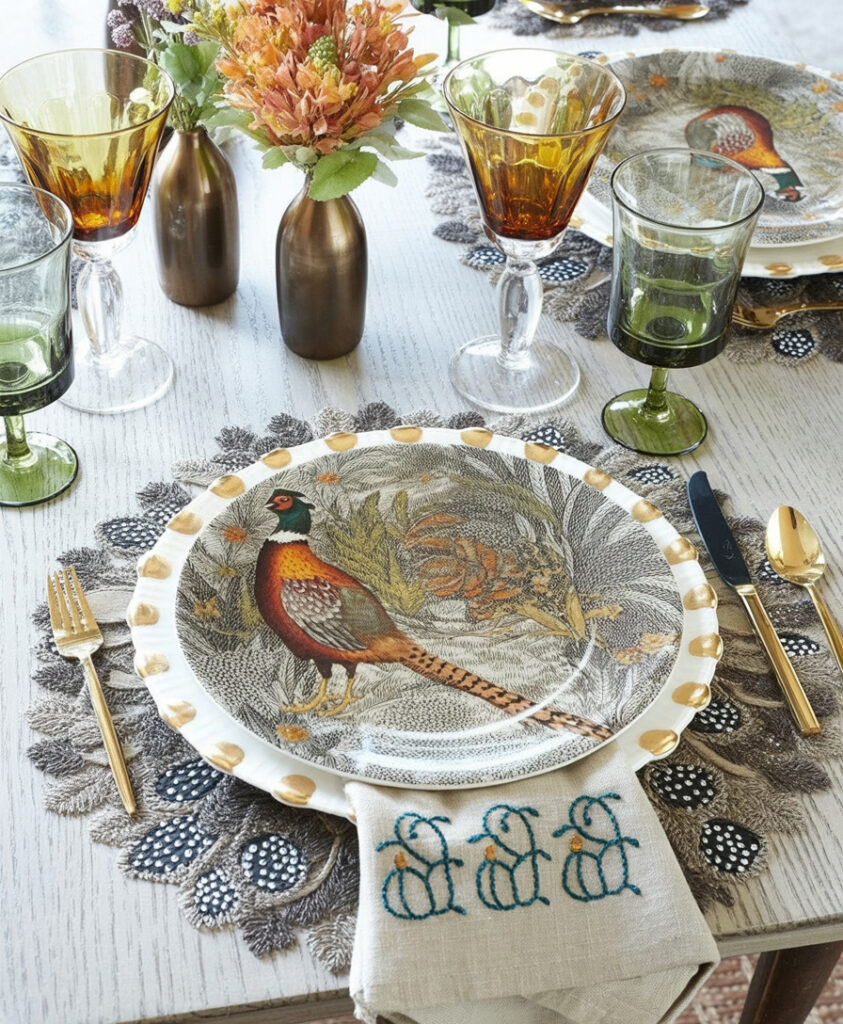Fall Tablescape
Creating a Countryside Fall Tablescape: Beyond Pumpkins and Turkey
When autumn arrives, most of us instinctively reach for the familiar orange pumpkins and turkey motifs for a fall tablescape. But this season, consider taking inspiration from the wild beauty you’d encounter on a countryside drive—where pheasants dart through golden fields and nature’s palette extends far beyond the expected fall colors.
Starting with Your Theme: The Art of Intentional Design
The most captivating tablescapes begin not with a shopping list, but with a story. This particular setting whispers of early morning walks through rustling leaves, the flash of a ring-necked pheasant’s iridescent feathers, and the sophisticated beauty of wildlife in its natural habitat. By choosing this countryside pheasant theme, you immediately elevate your table from seasonal to timeless, creating a conversation starter that feels both elegant and grounded in nature.
The key to successful theme development lies in specificity. Rather than “fall table,” think “English countryside in November” or “hunting lodge elegance.” This focused vision becomes your North Star, guiding every subsequent choice from dinnerware to napkin rings.
Building Your Color Story
Notice how this tablescape moves beyond the predictable autumn palette of orange and red. Instead, it embraces the subtle sophistication of amber glass, sage green stemware, and the rich browns and golds found in actual pheasant plumage. The whites and creams provide breathing room, preventing the earthier tones from feeling heavy.
This restrained color approach is what separates sophisticated seasonal decorating from overwhelming holiday chaos. Choose three to four colors maximum, and let them repeat throughout your table in varying intensities. The amber glasses echo the golden tones in the pheasant plate, while the sage green stemware picks up the muted greens in the foliage pattern.
Layering Textures for Visual Interest
The magic happens in the layering. Start with your foundation—here, a weathered wood table provides organic texture that speaks to the countryside theme. The guinea fowl feather placemat beneath creates pattern and movement while maintaining the bird motif without being literal.
Each element adds a different textural note: the smooth ceramic of the decorative plate contrasts beautifully with the faceted amber glassware, while the soft linen napkin with its simple embroidered pumpkins adds just enough seasonal reference without overwhelming the more sophisticated pheasant motif.
The Power of Mixed Metallics
Don’t overlook the metal bud vases and golden flatware—metallics ground your color palette and add warmth. In fall tablescapes, warm metals like brass, copper, and gold work harder than silver, creating that cozy, fireside feeling that makes guests want to linger.
Implementation Strategy: Building Your Look
Start with your hero piece: In this case, the pheasant dinner plate sets the entire tone. Find your statement piece first, then build around it rather than trying to coordinate multiple bold elements.
Invest in versatile glassware: Those amber and green vintage-style glasses work for fall entertaining but aren’t so specifically seasonal that you can’t use them year-round for casual dinners.
Think beyond literal interpretations: The embroidered pumpkin napkin is the only overtly “fall” element, and it’s small enough to feel charming rather than theme-park obvious. The rest of the table suggests autumn through color and feeling.
Create height and movement: The simple chrysanthemum arrangement in brass vessels adds life without competing with your dishware. Keep florals simple when your plates are doing the pattern work.
Making It Your Own
This approach works because it’s rooted in genuine inspiration rather than catalog copy. Whether your countryside inspiration comes from pheasants, wild turkeys, or deer glimpsed through morning mist, the principle remains the same: start with an authentic moment or image, then translate that feeling through thoughtful color choices, varied textures, and restrained seasonal elements.
The result is a table that feels collected rather than purchased, sophisticated rather than obvious, and most importantly, uniquely yours. Your guests will remember the feeling of this table long after the last course is served—and isn’t that the real goal of memorable entertaining?

